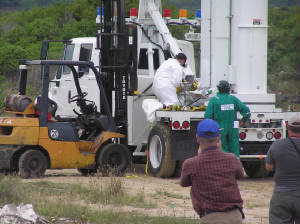by
Gus Iversen, Editor in Chief | December 09, 2015

Cobalt-60 Source Transfer
in Venezuala Courtesy:
Foss Therapy Services, Inc.
Because of the challenges and risks associated with handling radioactive isotopes, it can be difficult — and costly — to find independent service contractors who are willing and able to remove Cobalt-60 from a medical device such as a Gamma Knife.
For over fifty years, Cobalt-60 has been used in external beam radiotherapy cancer treatment. The isotope yields greater precision and power than the X-rays that preceded it, which means it can penetrate deeper into the patient's body and work more efficiently to kill tumors.
Although modern linear accelerators have enhanced the capabilities of X-ray radiotherapy and developed as a somewhat parallel technology to Gamma Knife, Cobalt-60 remains an invaluable weapon against cancer for many hospitals.



Ad Statistics
Times Displayed: 124055
Times Visited: 7200 MIT labs, experts in Multi-Vendor component level repair of: MRI Coils, RF amplifiers, Gradient Amplifiers Contrast Media Injectors. System repairs, sub-assembly repairs, component level repairs, refurbish/calibrate. info@mitlabsusa.com/+1 (305) 470-8013
Foss Therapy Services has been providing radiation therapy equipment services since 1991. Joe Shepherd, president, told HCB News that removing Cobalt-60 from radiotherapy equipment requires a portable hot cell ("large lead and steel box") so that you can transport the radioactive product from its holder and place it into a shipping container.
When a customer is interested in Gamma Knife removal, Shepherd asks questions pertaining to the age and the size of the cobalt source. "Then the device model number so we know what we’re dealing with, as well as facility logistics — what kind of space do we have to do the work," he said.
From there, he described a couple of different options. The Off-Site Source Recovery Program (OSRP) is a useful service because it also assists in offsetting the costs of disposal, but Shepherd says it can take as many as six years for it to complete a removal. Instead, Foss Therapy Services typically moves the sources to a cobalt manufacturing company where the material can safely be recycled.
"It all takes about two days of set-up, two-days of course removal, and a day and a half to two days to tear down," he said.
In 2012, a highly publicized — and somewhat accidental —
theft of Cobalt-60 left a region of Mexico in a state of panic. Hijackers inadvertently acquired a supply of the material when they took over a truck.
Fortunately, when the Cobalt-60 turned up, the protective tube concealing the radioactive material had reportedly not been opened. If it had been, the consequences could have been dire for the nearby residents of Hueypoxtla, a town near Mexico City.
“All you can do is supportive care, perhaps steroids and IV fluids and monitoring, and doing what you can,” Dr. James O'Donnell, division chief of nuclear medicine at the University Hospitals Case Medical Center in Cleveland,
told FoxNews.com, in the wake of that event.

